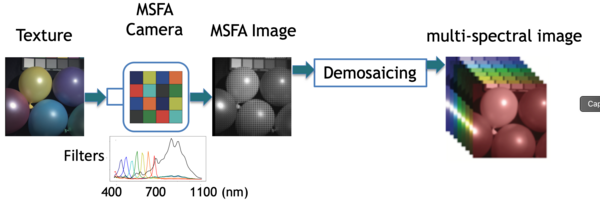
Ludovic Macaire
Axes de recherche
Color image analysis
- Results obtained by the Color Imaging team of CRIStAL laboratory is detailed at:
-
Website of the team with the data, benchmarks and JAVA sources...

Color Filter Array Image Analysis
The team Color Imaging whose I am the leader, designs automatic analysis of Color Filter Array images acquired by cameras equipped with one single sensor that is sensitive to the incident light in the visible and near infra-red spectral domains.
Although three-sensor technology provides high-quality full-color images, the manufacturing costs of the sensors and of the optical device are high. As a consequence, cameras fitted with such sensors have not yet been affordable to everyone, nor widely distributed. Due to these cost constraints, most color cameras are equipped with a single sensor, which also allows for an increased spatial resolution at given cost in comparison with three-sensor cameras. The surface of this single sensor is covered by a color filter array (CFA), which consists of an array of spectrally selective filters. Each photosite is then made mainly sensitive to a given wavelength band corresponding to a single color component. The Bayer filter array is the most widely used one; it provides a CFA image in which each pixel is characterized by only one among the three color components. The levels of the missing two color components must be determined to estimate the color of each pixel. This process is commonly referred to as CFA demosaicing; its result is the demosaiced color image, in which each pixel is characterized by an estimated color. Demosaicing is either achieved by an electronic device inside the camera itself, or by an external software that processes the CFA image delivered by the camera as a raw image file.
The developed procedures must be adapted to the lattice of these CFA images. Indeed, the spatial and spectral correlation properties are different from those of color images. They are exploited for either demosaicing, but also for texture characterization. Those texture features models the specific neighborhood relationships in the CFA images.

MSFA (Multi-Spectral Filter Array) image analysis
The color is not always sufficient to well represent the spectral reflectance properties of objects in natural scenes. That is the reason why images can be acquired by multi-spectral cameras. Because these systems are expensive and are sensitive to a limited number of bands, single- sensor snapshot systems have been recently developed. Most of them use a multispectral filter array (MSFA) laid over the sensor that spectrally samples the incident light, like the widely used Bayer color filter array (CFA) in color imaging. The MSFA is defined by a basic periodic pattern in which each filter is sensitive to a narrow spectral band. Each pixel of the resulting raw image is then characterized by one single band according to the MSFA. We presently work on
- the spectral characterization of MSFA cameras used in uncontrolled conditions,
- the low-level MSFA image analysis (denoising, demosaicing) to obtain spectral cubes,
- design of new spectral texture features.




